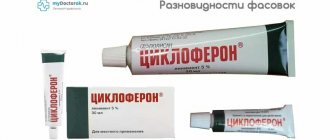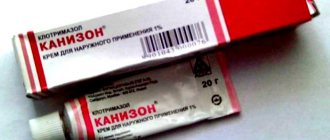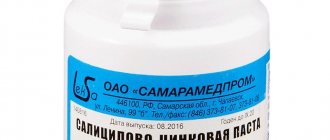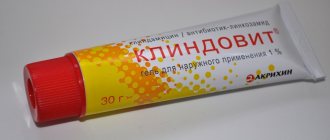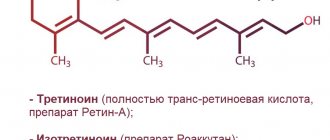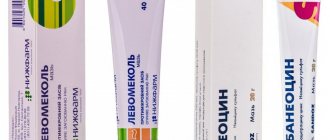Floxal is a local antibacterial drug. Available in the form of drops and eye ointment. The drops are a pale yellow transparent solution. They can be purchased in a polyethylene bottle in the form of a dropper in an amount of 5 ml.
Eye ointment is a homogeneous substance with a pale yellow color. Available in aluminum tubes. One tube contains 3 grams of ointment. Both forms of the drug are packaged in a cardboard box with instructions inside.
Pharmacological authorities
Pharmacodynamics.
Ofloxacin, similar to quinolonic acid, is a fluoroquinolone (hyrase inhibitor), an antibiotic that has a bactericidal effect.
Limit values
Testing of ofloxacin is based on the highest dilution series. The following minimum inhibitory concentrations have been established for sensitive and resistant bacteria:
EUCAST (European Committee on Antimicrobial Sensitivity Testing) limit values:
| Pathogen | Sensitive | Resistant |
| Enterobacteriaceae | ≤0.5 mg/l | >1 mg/l |
| Staphylococcus spp. | ≤1 mg/l | >1 mg/l |
| Streptococcus pneumoniae | ≤0.125 mg/l | >4 mg/l |
| Haemophilus influenzae | ≤0.5 mg/l | >0.5 mg/l |
| Moraxella catarrhalis | ≤0.5 mg/l | >0.5 mg/l |
| Neisseria gonorrhoeae | ≤0.12 mg/l | >0.25 mg/l |
| Threshold values that do not bother a particular species* | ≤0.5 mg/l | >1 mg/l |
* Important on the basis of the pharmacokinetics of the syrup.
The spectrum of effectiveness of ofloxacin includes oblique anaerobes, facultative anaerobes, aerobics and other microorganisms, such as chlamydia.
The breadth of the developed resistance of song species may change locally over time. Therefore, especially when dealing with important infections, local information about resistance is essential. Looking at local resistance, there is doubt about the effectiveness of ofloxacin, following the success of expert therapy. Zocrem, in the event of important infections or therapeutic failure, microbiological diagnostics with a confirmed pathogen and sensitivity to ofloxacin should be avoided. Chronic resistance to ofloxacin with other fluoroquinolones is possible.
The information provided below is based primarily on the observed day-to-day resistance from 1391 isolated ocular examinations (most importantly, external smears) from 31 German centers. These data serve as the basis for the systematic determination of significant boundary values. For local administration of ofloxacin, a significantly higher concentration of antibiotic is available at the anterior part of the eye than for systemic administration, so clinical effectiveness in these indications may also be given for pathogens such as were designated as resistant, for example. Enterococcus spp.
., under the hour of development of
in vitro
resistance to
in vitro
.
Call for sensitive species
Gram-positive aerobes: Bacillus spp., Staphylococcus aureus
(sensitive to methicillin),
Gram-negative aerobes: Acinetobacter baumannii, Acinetobacter lwoffi, Enterobacter cloacae, Escherichia coli, Haemophilus influenzae, Haemophilus parainfluenzae, Klebsiella oxytoca, Klebsiella pneumoniae, Moraxella catarrhalis, Proteus mirabilis, Serratia marcescens.
Types that are inherited from developed resistance may be insensitive to the drug when it is frozen
Gram-positive aerobes: Corynebacterium spp., Enterococcus faecalis, Staphylococcus aureus
(resistant to methicillin)1,
Staphylococcus epidermidis, Streptococcus pneumoniae2
, streptococci (surrounding
Streptococcus pneumoniae
)2.
Gram-negative aerobes: Pseudomonas aeruginosa, Stenotrophomonas maltophilia.
See how natural resistance to the drug looms
Gram-positive aerobes: Enterococcus spp.
1
The level of resistance exceeds 50% in one region.
2 The natural sensitivity of most species lies at the middle boundaries. However, in the case of tears, after one instillation a concentration of at least 4 mg/l is achieved
4 years, which is enough to kill 100% of microorganisms.
Pharmacokinetics.
The effectiveness depends on the maximum concentration of the drug in tissues (C max) and the minimum inhibitory concentration (MIC) for the body.
Experiments on animals have shown that after local administration of ofloxacin, there may be manifestations in the cornea, conjunctiva, ocular tissue, sclera, iris, ciliary body and in the anterior chamber of the eye. Bagatorazov zastosuvannya can also be brought to therapeutic concentrations in an ambiguous body.
After a one-time soaking of the ointment, add approximately 1 cm (which is equivalent to
0.12 mg ofloxacin) the maximum concentration of ofloxacin in the conjunctiva (9.72 mcg/g) and sclera (1.61 mcg/g) is reached after 5 minutes. Then the concentration changes completely.
After a year, concentrations in the internal eye and corneas reach a maximum value of 0.69 mcg and 4.87 mcg, respectively.
pharmachologic effect
Ofloxacin is the active ingredient of the drug and belongs to the fluoroquinol group of antibiotics. Ofloxacin is a broad-spectrum antibiotic.
It is used against some gram-positive and gram-negative aerobic bacteria, which include the causative agents of chlamydial and mycoplasma conjunctivitis, staphylococcal and streptococcal infections.
The drug has a bactericidal effect due to destabilization of the DNA chains of microorganisms, which leads to their death.
Features of good stagnation
The safety and effectiveness of administration of the drug in children up to 1 year of age has not been demonstrated. Severe and possibly fatal (anaphylactic and anaphylactoid) hypersensitivity reactions have been reported following cessation of first doses in patients who were withdrawing quinolones, including or ofloxacin, systemically. These reactions were accompanied by cardiac-vascular collapse, loss of information, angioneurotic swelling (including swelling of the larynx, throat and facial swelling), obstruction of the respiratory routes, buttocks, urticaria and itching. When ingested with ofloxacin, an allergic reaction occurs as a consequence of the ingestion. Use Floxal® 3 mg/g as an ophthalmic ointment with caution in patients who have already responded sensitively to other antibiotics—quinolones. When using an ointment that contains ofloxacin, there is a risk of nasopharyngeal passage, which can lead to the development of bacterial resistance. As with other antibiotics, prolonged stagnation can lead to the appearance of insensitive microorganisms. If the infection develops or the clinical progression is not prevented within a certain period of time, after the drug has been allowed to stagnate and an alternative treatment has been developed. There is little evidence of the effectiveness and safety of ophthalmic drugs using 0.3% ofloxacin for the treatment of conjunctivitis in newborns. Use of ocular preparations with ofloxacin in newborns for the treatment of neonatal ophthalmia, caused by Neisseria gonorrhoeae
or
Chlamydia trachomatis
, is not recommended, as its persistence has not been studied in this group of patients.
Clinical and non-clinical publications report the incidence of corneal perforation in patients with corneal epithelium deficiency or corneal lesions that have been treated with hand-held fluoroquinolone antibiotics. However, from these reports there is a lot of significant inaccurate data about such factors as summer age, the presence of major diseases, concomitant eye illnesses (for example, very dry eyes), systemic ignition illnesses (for example, rheumatoid arthritis) or immediate administration of steroids or non-steroidal anti-inflammatory drugs into the body medicinal benefits. Regardless of the risk of corneal perforation, doctors must be careful when administering this medication to patients with severe defects in the corneal epithelium or corneal bulge. When using different ophthalmic drugs to replace ofloxacin, deposits on the cornea were recorded. No causal and hereditary connections can be made. During the course of treatment with ofloxacin, there is a possibility of light sensitivity. It is not recommended to wear contact lenses while treating eye infections. Lanolin can cause skin irritation (for example, contact dermatitis). Before the first administration of the drug, it is necessary to conduct microbiological examination of smears taken from the conjunctival sac to determine the sensitivity of bacterial strains to the drug. In case of dry stagnation, it is possible to form bacterial resistance and create microorganisms that are insensitive to antibacterial properties. In case of worsening symptoms or the presence of clinical symptoms, it is necessary to initiate treatment and alternative therapy. During the bathing hour, do not use hard contact lenses. It is therefore recommended to remove hard lenses before drying the drug and treating their symptoms no earlier than 20 weeks after administering the drug. Under the hour of application of the drug Floxal®, the ointment is intended to be applied to soft contact lenses. Apply Floxal® ointment at the same time as other eye drops/eye ointments no earlier than 15 minutes after the other drug has been infused. If someone has an episode, the ointment should be left behind. With prolonged systemic therapy with fluoroquinolones, concomitant with ofloxacin, tendon inflammation and rupture may occur, especially in late-life patients and those patients who immediately recovered from corticosteroid treatment. Therefore, be careful and apply a bath with the drug Floxal®, ointment, if there are any signs of inflammation of the tendon (section “Adverse reactions”). In case of systemic ingestion of fluoroquinolones, with care of traces of congestion, the drug should be taken in patients with a risk of prolonged QT interval, and also in patients with congenital QT interval syndrome, in case of one-hour stagnation of drugs, such as comfort QT interval (for example, antiarrhythmic drugs class IA and III, tricyclic antidepressants, macrolides , antipsychotic disorders), with unregulated electrolyte balance (for example, hypokalemia, hypomagnesemia), summer patients, patients with cardiac diseases (for example, heart failure, etc.) myocardial infarction, bradycardia). Suspension during pregnancy or breastfeeding.
Regardless of the presence of any embryotoxic infusions, Floxal® ointment should not be used during pregnancy or breastfeeding.
It is possible to influence the fluidity of the reaction during treatment with motor vehicles or other mechanisms.
After administration at the conjunctival sac, the drug can lead to loss of clarity of vision on the spine. Until the clarity of vision is restored, patients should avoid using vehicles or using other machinery.
Method of congestion and dosage
The dose of the drug and the severity of the treatment are determined by the doctor depending on the severity of the illness and the age of the patient. Unless otherwise prescribed, in adult and children (age 1), inject a 1 cm thick ointment into the conjunctival sac of the affected eye (equivalent to 0.12 mg ofloxacin) 3 times per dose (for chlamydia infections ˗ 5 times per dose). Treatment with Floxal®, ointment, without guilt, overindulge for 2 years. Vkazivki shodo zastosuvannya.
Carefully pull the lower lip down and, lightly pressing on the tube, inject the required amount of ointment into the conjunctival sac. Then close the lid and carefully press the apple on one side to distribute the preparation evenly.
Note: if you additionally use other eye drops/eye ointments, the interval between use should be 15 minutes, first use the remaining ointment.
Children.
Floxal®, ochnu ointment, can be prescribed to children under the age of 1.
Application area
Release form: eye drops, ointment. The packaging is made of cardboard, made in white with a horizontal blue stripe along the top edge, and an eye is depicted in the center of the front side. Country of origin: Germany.
It is used to treat infectious and inflammatory diseases of the anterior part of the eye, barley, conjunctivitis, as well as bacterial infections after surgery or eye injury.
Dispensed from pharmacies with a doctor's prescription.
When it comes to eye treatment, medications should be used very carefully and carefully. The main thing is to monitor the dosage, strictly follow the doctor’s instructions and do not forget about the rules for storing the product.
Side effects
Immediately after administration of the drug, blurred vision may occur for several decades.
Show it off
Serious reactions after systemic administration of ofloxacin are rare, most werewolf symptoms. Regardless of the fact that the insignificant amount of ofloxacin is absorbed from the systemic bloodstream during local congestion, it is impossible to exclude the possibility of side effects that have been reported.
On the side of the immune system
. Rarely: redness of the conjunctiva and/or easy to detect liver in the eye. Most seizures had no symptoms. In very rare cases (<1/10,000): increased sensitivity, including angioedema, shortness of breath, anaphylactic reactions/shock, swelling of the oropharynx and tongue, itching of the eyes and swelling.
On the side of the nervous system:
those who are alone are confused.
From the side of the organs
.
Frequently
: discomfort in the eyes, eye teasing;
rare: keratitis, conjunctivitis, blurred vision, photophobia, swelling of the eyes, red eyes, foreign body sensations, improved lacrimation, dry eyes, pain in the eyes, itching, increased swelling. In rare cases (ranging from 1/10,000 to 1/1,000), lesions on the cornea may occur, especially if there is a history of corneal illness.
And information about those that when applied locally, reactions such as toxic epidermal necrosis and Stevens-Johnson syndrome rarely occur. Cause-inheritance relationship with Floxalom®, ointment, so that such manifestations are not established.
On the side of the organs of the grass tract
: in lonely situations - tediousness.
From the side of the skin and under the skin:
in single episodes - facial swelling, periorbital swelling.
Serious, sometimes fatal, hypersensitivity reactions following administration of the first dose have been observed with systemic administration of quinolones.
The drug contains lanolin, which can cause contact dermatitis.
In patients who were withdrawing from systemic fluoroquinolones, ruptures of the shoulder tendon, hand, Achilles tendon, or other tendons were reported, which required surgical repair or resulted in permanent loss of life atnostі. Further research and follow-up evidence of the depletion of systemic fluoroquinolones indicates that the risk of such reactions may be increased in patients who are withdrawing corticosteroids, especially in patients And in the summer century, and with great attention to the tendon, the Achilles tendon.


